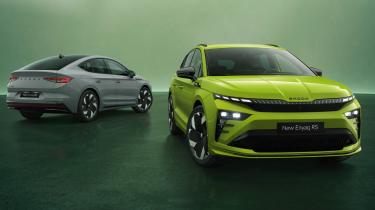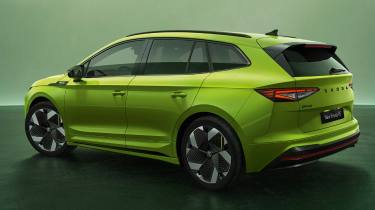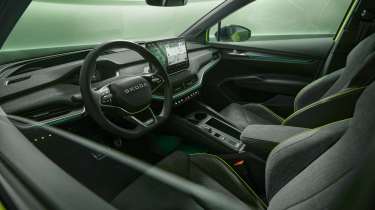Updated 2025 Skoda Enyaq vRS has a fresh face to match its 335bhp punch
Very modest mechanical changes sit behind a totally new look for Skoda’s hot electric SUV
Skoda has revealed its updated Skoda’s Enyaq vRS, complete with a new face, a decent power bump and a price to undermine its closest rivals and platform mates, the Ford Capri, Audi Q4 e-tron Volkswagen ID.4 GTX and Cupra Tavascan VZ. Starting from £51,660 in SUV form and £53,560 in coupe form, the latter undercuts the identically-powerful dual-motor Capri by just under £3k and the Cupra by just over £2k, while skimming under the Volkswagen’s bottom line by less than £200.
Being identical mechanically to the aforementioned rivals (and indeed, the outgoing Enyaq vRS) means the Enyaq vRS has an electric motor at each axle, with a 335bhp total output. The pre-facelift Enyaq vRS received a significant powertrain upgrade in 2023 to give it the 40bhp boost to 335bhp and maximum of 403lb ft. This helped to improve acceleration by a second, dropping the 0-62mph time to 5.5sec. The new facelifted car uses software revisions to shave a further 0.1sec off, for a new 5.4sec time (quicker than bonafide hot hatches like the Honda Civic Type R), to make the Enyaq vRS twins (coupe and SUV) the joint-fastest-accelerating Skodas, alongside the recently revealed Elroq vRS. No prizes for guessing that this twin-motor powertrain is shared across these electric vRS models. Top speed however, is unchanged at 111mph.
Range is slightly improved with Skoda claiming the new Enyaqs will be good for over 340 miles (no precise numbers have been given), a modest improvement on the 336-mile stated range of the outgoing car. That’s thanks to the slightest bump in battery size, to 79kWh net (vs 77kWh net before), or in other words, the battery upgrade shared by everything from the Cupra Born VZ to the Ford Capri dual-motor. Charging speeds are modestly improved too, with the jump from 10 to 80 percent possible in 26 minutes (down from 28 minutes) when charging at the 185kW maximum (up from 175kW before).
The biggest change to the Enyaq vRS then is its design – truthfully, something that should have arrived in conjunction with the 2024MY’s performance upgrades. That said, the hardware boost was more sorely needed after our lukewarm experience of the original 295bhp Enyaq vRS.
This new face is a total do-over, with a new split light design with the DRLs up top and the main lights lower down. This is probably one of the most fashionable and prevalent car design tropes of the moment, spanning everything from the Ferrari Purosangue to the BMW 7-series. The slimming down of the Skoda grille and that new light treatment does perhaps drain the Enyaq of what little personality and distinctly ‘Skoda’ identity it did have before. Still, it’s not an unpleasant-looking thing – certainly not by comparison to the Ford Capri. At the rear, much less has changed, to the point that pre- and post-facelift cars are almost indistinguishable. The usual sportier gloss black trim pieces, along with vRS badging, mark it out as the flagship, along with the lurid green paint should you be brave enough to spec it.
On the inside the 5-inch Digital Cockpit and 13-inch infotainment display are as per the standard Enyaq (albeit with sportier vRS-themed skins), with the climate controls still held hostage behind pixels, while the traditional Skoda badge on the steering wheel has made way for Skoda script. Standard vRS Suite spec on the inside gets you a mix of leather and artificial leather with grey stitching. Upgrade to vRS Lounge spec and you get microsuede and lime green contrast stitching for a bit more flare. As per the vRS remit of being well-equipped from the getgo, the front sports seats are heated and come with massage functionality, though a heat pump remains a box to tick.
2025 Skoda Enyaq vRS price
As above Skoda has kept the Enyaq vRS competitive in terms of pricing. Nevermind sticking, the £51,660 for the SUV and £53,560 for the coupe are actually drops in price, especially when you factor in inflation. Still, not an insignificant sum of money and one that will earn buyers a nasty sting from the government’s expensive vehicle supplement tax, which applied to all cars over £40,000, and from which EVs are no longer exempt.
> 2025 VED car tax: what you'll be paying
The Enyaq vRS, as with all of these MEB-based cars, has been subject to consistent iteration and improvement. Even if it’s vastly improved by comparison to the first, though, we can’t see this being in the same league as the Octavia vRS, as a car with much more driving appeal than you’d imagine.







